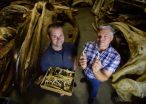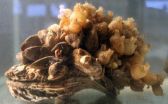(Press-News.org) A BREAKTHROUGH by a talented University of Huddersfield student has shown for the first time that people with psychopathic tendencies who have high IQs can mask their symptoms by manipulating tests designed to reveal their personalities. It raises the possibility that large numbers of ruthless risk-takers are able to conceal their level of psychopathy as they rise to key managerial posts.
Carolyn Bate, aged 22, was still an undergraduate when she carried out her groundbreaking research into the links between psychopathy and intelligence, using a range of special tests and analysing the data. She wrote up her findings for the final-year project in her BSc Psychology degree. Not only was she awarded an exceptionally high mark of 85 per cent, her work has also been accepted for publication by the peer-reviewed Journal of Forensic Psychiatry and Psychology – an unusual distinction for an undergraduate.
Carolyn, who has now graduated with First Class Honours, said that her project was triggered when she read about research which showed that while one per cent of the population were categorised as psychopaths, the figure rose to three per cent in the case of business managers.
"I thought that intelligence could be an explanation for this, and it could be a problem if there are increased numbers of psychopaths at a high level in business. The figure could be more than three per cent, because if people are aware they are psychopathic they can also lie – they are quite manipulative and lack empathy. This could have a detrimental effect on our everyday lives," said Carolyn, who added that some researchers have suggested that episodes such as the Wall Street Crash could be blamed on the numbers of psychopaths among decision makers.
She points out that, despite the media's invariably lurid use of the term, there are various categories of psychopath and they are not all prone to physical violence.
"The ones who are at the top of businesses are often charming and intelligent, but with emotional deficits, as opposed to psychopaths who are quite erratic and tend to commit gruesome crimes and are often caught and imprisoned."
Sufficient intelligence to fake their emotional response
To test her ideas, Carolyn assembled 50 participants, mostly from among students, who underwent a series of tests – conducted in strict confidence – beginning with an appraisal of IQ levels using a standard procedure. Then they completed the Levenson Self-Report Psychopathy Scale, which established which participants had either Factor One or Factor Two psychopathic tendencies.
Then Carolyn used the technique of Galvanic Skin Response (GSR). Electrodes were attached to the fingers of participants in order to gauge their reactions to images on a computer screen. They included pictures of crying children, people being threatened and scenes of natural disasters. There were no truly horrific images, but they were of the sort that would shock a completely normal person. However, a person with Factor One psychopathic tendencies – the sort more likely to become a business manager – would display little or no emotional response; while a Factor Two psychopath would demonstrate a heightened response due to excitement.
Carolyn found that the GSR responses among her participants were much as she would have predicted – except for the fact that it was only those with lower levels of intelligence who displayed the expected levels of excitement.
The conclusion is that those with higher IQs had sufficient intelligence to fake their emotional response, making it more difficult to detect their condition. This is the discovery that means Carolyn has made an original contribution to research in the field.
She has contemplated the implications and whether or not it is important to develop new procedures to screen out psychopathic people who are in line for top business posts.
"Perhaps businesses do need people who have the same characteristics as psychopaths, such as ruthlessness. But I suspect that some form of screening does need to take place, mainly so businesses are aware of what sort of people they are hiring," she says.
Having graduated in psychology, Carolyn – who is from Leeds and attended Abbey Grange Academy in West Park – is now heading in a different direction. She returns to the University of Huddersfield for a year in order to acquire a Postgraduate Certificate in Education, with the goal of becoming a maths teacher.
But she retains the fascination for psychology that led her to study the subject at degree level and she praises her University of Huddersfield tutors, including Dr Daniel Boduszek, Senior Lecturer in Criminal Psychology, who supervised her final-year project, now to be published. "I am really grateful to Dan, who was an excellent tutor," says Carolyn.
INFORMATION:
http://www.tandfonline.com/doi/abs/10.1080/14789949.2014.943798
New research shows that there could be increased numbers of psychopaths in senior managerial positions and high levels of business
2014-09-08
ELSE PRESS RELEASES FROM THIS DATE:
NRL scientist explores birth of a planet
2014-09-08
Dr. John Carr, a scientist at the U.S. Naval Research Laboratory, is part of an international team that has discovered what they believe is evidence of a planet forming around a star about 335 light years from Earth. This research is published in the August 20th issue of The Astrophysical Journal.
Carr and the other research team members set out to study the protoplanetary disk around a star known as HD 100546, and as sometimes happens in scientific inquiry, it was by "chance" that they stumbled upon the formation of the planet orbiting this star. A protoplanetary disk, ...
Novel cancer drug proves safe for leukemia patients
2014-09-08
WINSTON-SALEM, N.C. – Sept. 8, 2014 – Results of a Phase I clinical trial showed that a new drug targeting mitochondrial function in human cancer cells was safe and showed some efficacy. The findings, reported by doctors at Wake Forest Baptist Medical Center, are published in the current online edition of the journal Clinical Cancer Research.
"This drug is selectively taken up by cancer cells and then shuts down the production of energy in the mitochondria," said Timothy Pardee, M.D., Ph.D., director of leukemia translational research at Wake Forest Baptist and principal ...
New genomic editing methods produce better disease models from patient-derived iPSCs
2014-09-08
New Rochelle, NY, September 8, 2014—Highly valuable for modeling human diseases and discovering novel drugs and cell-based therapies, induced pluripotent stem cells (iPSCs) are created by reprogramming an adult cell from a patient to obtain patient-specific stem cells. Due to genetic variation, however, iPSCs may differ from a patient's diseased cells, and researchers are now applying new and emerging genomic editing tools to human disease modeling, as described in a comprehensive Review article published in Stem Cells and Development, a peer-reviewed journal from Mary ...
Living in the shadow of Mauna Loa: A silent summit belies a volcano's forgotten fury
2014-09-08
Alexandria, Va. — Earth's largest active volcano, Mauna Loa on Hawaii's Big Island, is taking a nap. And after 30 years, no one is sure when the sleeping giant will awaken. Scientists say it's likely to erupt again within the next couple of decades and, when it does, it will be spectacular — and potentially dangerous.
Although Mauna Loa often takes a back seat to the more famous Kilauea, which has been erupting nearly continuously since 1983, history warns us that Mauna Loa's current silence is anomalous. Meanwhile, more people and more buildings pack into potentially ...
Whale sex: It's all in the hips
2014-09-08
Both whales and dolphins have pelvic (hip) bones, evolutionary remnants from when their ancestors walked on land more than 40 million years ago. Common wisdom has long held that those bones are simply vestigial, slowly withering away like tailbones on humans.
New research from USC and the Natural History Museum of Los Angeles County (NHM) flies directly in the face of that assumption, finding that not only do those pelvic bones serve a purpose – but their size and possibly shape are influenced by the forces of sexual selection.
"Everyone's always assumed that if you ...
Study puts some mussels into Bay restoration
2014-09-08
Restoring oysters—and their ability to filter large volumes of water—is widely seen as a key way to improve the health of Chesapeake Bay. New research makes this calculus even more appealing, showing that the mussels that typically colonize the nooks and crannies of a restored oyster reef can more than double its overall filtration capacity.
The study—by researchers at the University of Maryland, the Smithsonian Environmental Research Center, and the Virginia Institute of Marine Science—appears as the cover story in the most recent issue of Restoration Ecology.
"Many ...
New targets for treating pulmonary hypertension found
2014-09-08
Two new potential therapeutic targets for the treatment of pulmonary arterial hypertension, a deadly disease marked by high blood pressure in the lungs, have been identified by researchers at the University of Illinois at Chicago. Their findings are reported in the American Journal of Respiratory and Critical Care Medicine.
Early symptoms of pulmonary arterial hypertension include shortness of breath and exercise intolerance. As the disease progresses, patients may require oxygen supplementation and lung transplantation. Heart failure can develop and is a major cause of ...
New compound inhibits enzyme crucial to MERS and SARS viruses, with a catch
2014-09-08
Scientists at the University of Illinois, Chicago, have identified a compound that effectively inhibits an enzyme crucial to the viruses that cause Middle East respiratory syndrome (MERS) and severe acute respiratory syndrome (SARS). The compound appears to have a different method of inhibition in each virus due to slight differences in each virus' enzyme which means finding other compounds that inhibit both may be difficult according to research presented at the 54th Interscience Conference on Antimicrobial Agents and Chemotherapy (ICAAC) an infectious disease meeting ...
How quickly viruses can contaminate buildings and how to stop them
2014-09-08
Using tracer viruses, researchers found that contamination of just a single doorknob or table top results in the spread of viruses throughout office buildings, hotels, and health care facilities. Within 2 to 4 hours, the virus could be detected on 40 to 60 percent of workers and visitors in the facilities and commonly touched objects, according to research presented at the 54th Interscience Conference on Antimicrobial Agents and Chemotherapy (ICAAC), an infectious disease meeting of the American Society for Microbiology.
There is a simple solution, though, says Charles ...
A low-energy optical circuit for a new era of technology
2014-09-08
Unlike electronic circuits, optical, or "photonic", circuits work with light rather than electricity, which makes them 10 to 100 times faster. They are also more energy-efficient because they show lower heat loss, better signal-to-noise ratios and are less susceptible to interference. Used especially for communications (e.g. fiber optics), optical circuits may use tiny optical cavities as 'switches' that can block or allow the flow of light, similarly to transistors in electronics. EPFL scientists have now fabricated and experimentally tested a silicon-based 'photonic crystal ...




